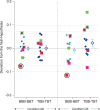Top-down resolution of visual ambiguity - knowledge from the future or footprints from the past?
- PMID: 34673791
- PMCID: PMC8530352
- DOI: 10.1371/journal.pone.0258667
Top-down resolution of visual ambiguity - knowledge from the future or footprints from the past?
Abstract
Current theories about visual perception assume that our perceptual system weights the a priori incomplete, noisy and ambiguous sensory information with previous, memorized perceptual experiences in order to construct stable and reliable percepts. These theories are supported by numerous experimental findings. Theories about precognition have an opposite point of view. They assume that information from the future can have influence on perception, thoughts, and behavior. Several experimental studies provide evidence for precognition effects, other studies found no such effects. One problem may be that the vast majority of precognition paradigms did not systematically control for potential effects from the perceptual history. In the present study, we presented ambiguous Necker cube stimuli and disambiguated cube variants and systematically tested in two separate experiments whether perception of a currently observed ambiguous Necker cube stimulus can be influenced by a disambiguated cube variant, presented in the immediate perceptual past (perceptual history effects) and/or in the immediate perceptual future (precognition effects). We found perceptual history effects, which partly depended on the length of the perceptual history trace but were independent of the perceptual future. Results from some individual participants suggest on the first glance a precognition pattern, but results from our second experiment make a perceptual history explanation more probable. On the group level, no precognition effects were statistically indicated. The perceptual history effects found in the present study are in confirmation with related studies from the literature. The precognition analysis revealed some interesting individual patterns, which however did not allow for general conclusions. Overall, the present study demonstrates that any future experiment about sensory or extrasensory perception urgently needs to control for potential perceptual history effects and that temporal aspects of stimulus presentation are of high relevance.
Conflict of interest statement
The authors have declared that no competing interests exist.
Figures












Similar articles
-
Can I trust in what I see? EEG evidence for a cognitive evaluation of perceptual constructs.Psychophysiology. 2016 Oct;53(10):1507-23. doi: 10.1111/psyp.12702. Epub 2016 Jul 8. Psychophysiology. 2016. PMID: 27387041
-
A different view on the Necker cube-Differences in multistable perception dynamics between Asperger and non-Asperger observers.PLoS One. 2017 Dec 15;12(12):e0189197. doi: 10.1371/journal.pone.0189197. eCollection 2017. PLoS One. 2017. PMID: 29244813 Free PMC article.
-
Large EEG amplitude effects are highly similar across Necker cube, smiley, and abstract stimuli.PLoS One. 2020 May 20;15(5):e0232928. doi: 10.1371/journal.pone.0232928. eCollection 2020. PLoS One. 2020. PMID: 32433672 Free PMC article.
-
Perceptual rivalry across animal species.J Comp Neurol. 2020 Dec 1;528(17):3123-3133. doi: 10.1002/cne.24939. Epub 2020 Jun 1. J Comp Neurol. 2020. PMID: 32361986 Free PMC article. Review.
-
The Certainty of Ambiguity in Visual Neural Representations.Annu Rev Vis Sci. 2021 Sep 15;7:465-486. doi: 10.1146/annurev-vision-100419-125929. Annu Rev Vis Sci. 2021. PMID: 34524881 Free PMC article. Review.
Cited by
-
Behavioural and EEG correlates of forward and backward priming-An exploratory study.PLoS One. 2025 May 8;20(5):e0322930. doi: 10.1371/journal.pone.0322930. eCollection 2025. PLoS One. 2025. PMID: 40338855 Free PMC article.
-
Visual imagination can influence visual perception - towards an experimental paradigm to measure imagination.Sci Rep. 2024 Oct 18;14(1):24486. doi: 10.1038/s41598-024-74693-x. Sci Rep. 2024. PMID: 39424908 Free PMC article.
References
Publication types
MeSH terms
Associated data
LinkOut - more resources
Full Text Sources
Miscellaneous

